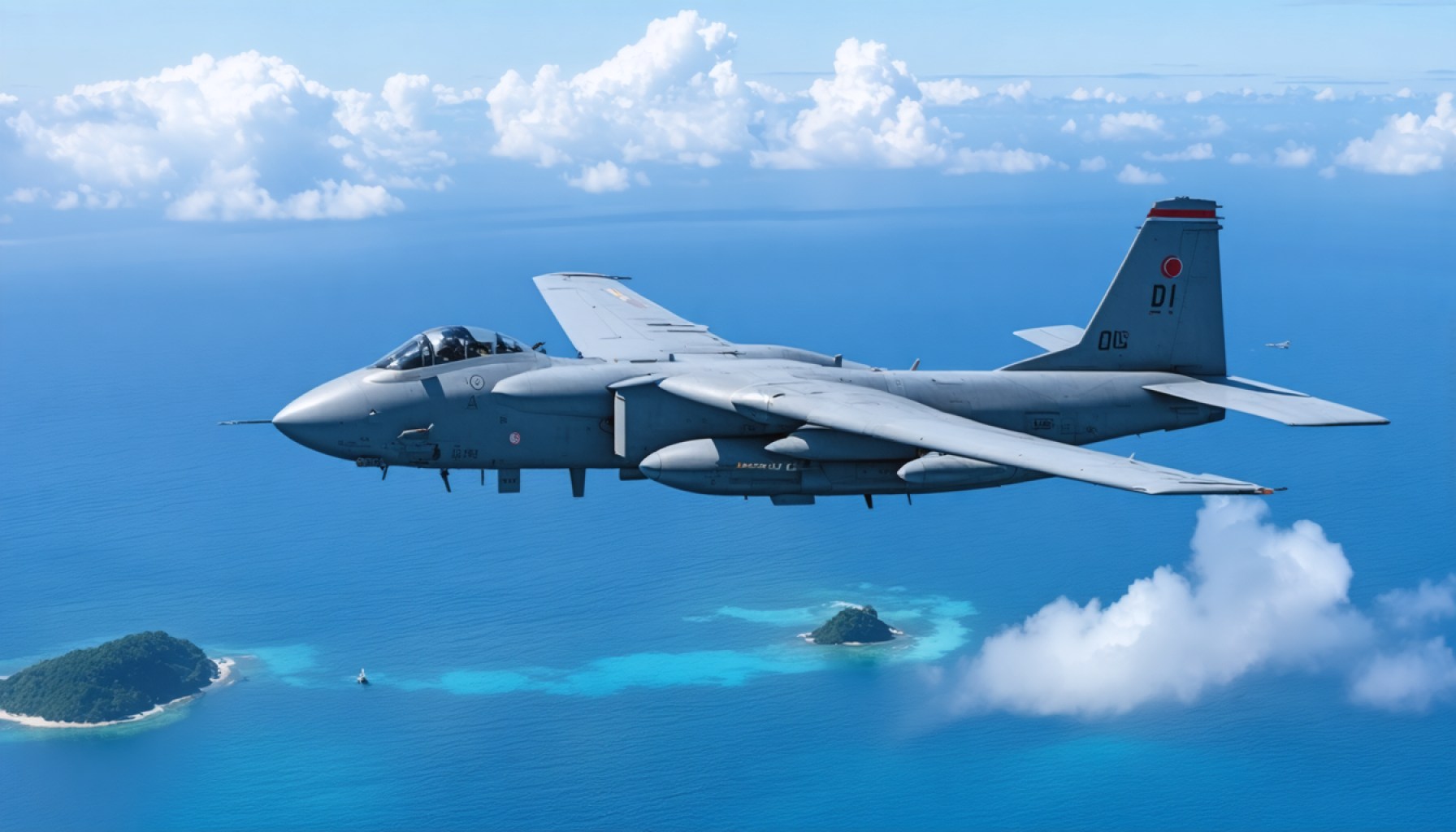- Chinese military drones have increased flights around Japan’s Nansei Islands, leading to 30 Japanese fighter jet scrambles in fiscal year 2024, the highest ever.
- The airspace between Japan’s Yonaguni Island and Taiwan is now frequently traversed by China’s reconnaissance and attack drones, including the TB-001 and BZK-005.
- China uses these drones to reinforce its defense around the First Island Chain and assert dominance over Taiwan and nearby waters.
- The drone pathways underscore China’s military ambitions and its sovereign claims over Taiwan.
- Persistent Chinese coast guard presence near the disputed Senkaku Islands maintains regional tensions.
- The situation illustrates the strategic intersection of technology and geopolitics, emphasizing the need for international cooperation and alliances.
- Heightened tensions in East Asia call for careful diplomatic navigation to prevent potential conflicts.
The skies over Japan have become a bustling theater of strategic maneuvering as Chinese military drones intensify their flight patterns around the Nansei Islands. This remote yet crucial expanse forms the backbone of Japan’s southwestern defenses and has witnessed an unprecedented military spectacle over the past year. Japanese fighter pilots sprang into action thirty times in the fiscal year 2024—their highest scramble count ever—responding to the ominous hum of unmanned aerial vehicles from China. These skyward confrontations invite scrutiny into an escalating regional dynamic fraught with geopolitical implications.
Japan’s defense ministry takes a calculated measure of these events: a direct response to China’s ever-expanding and active military presence in the region, which has reached surprising new heights. Once quiet, the airspace envelope between Japan’s Yonaguni Island and Taiwan now echoes with the persistent sweep of reconnaissance and attack drones, humming through pathways across the East China Sea and out over the Pacific.
Among these mechanical visitors, sometimes cloaked in ambiguity, lie formidable machines—the TB-001 and the BZK-005—whose technologically advanced sensors offer a surveillance reach that resonates alarmingly close to Japan’s own territory. At the helm of these crafts, Beijing’s strategic intent becomes clear: to reinforce its defensive perimeter, the crucial First Island Chain, against perceived U.S. military postures and to assert dominance over the sensitive waters around Taiwan.
In a year marked by complex choreography, China’s drones wove a compelling narrative—17 of these sorties traced paths from Yonaguni Island to Taiwan, a testament to Beijing’s unwavering commitment to its sovereign claims over Taiwan, which it views as a renegade province. The paths these drones carve serve dual purposes, bolstering China’s military capabilities while doubling as persistent signals of its geopolitical ambitions.
But as these robotic flights ripple through international airspace, they also bring points of tension into sharper focus, affecting the sands of diplomacy in East Asia. On the ground, China’s implacable coast guard vessels continue to stir the troubled waters surrounding the Senkaku Islands—an archipelago claimed by both Japan and China—maintaining a persistent and, at times, provocative presence.
This unfolding drama over the Nansei Islands and beyond highlights the critical intersection of advanced technology and global power plays—a reminder of the importance of international cooperation. As Japan keeps a vigilant eye on its eastern skies, the need for strategic alliances and shared vigilance seems more pressing than ever. Striking a balance becomes pivotal as Japan navigates these choppy waters through partnerships with like-minded nations to preserve peace and stability in a region where tensions can quickly rise to a boiling point.
This ongoing aerial chess match not only exposes the strategic friction points between two regional powers but also illustrates the heightened stakes at the crossroads of technology, territory, and sovereignty. As nation-states jockey for position, the world watches closely, knowing the slightest miscalculation could tip the scale into uncharted and dangerous territory.
Drone Showdown in the Skies: The Intensifying Aerial Chess Match Between Japan and China Over the Nansei Islands
Unseen Dimensions of the Japan-China Drone Standoffs
The increasing activity of Chinese military drones near Japan’s Nansei Islands presents not only a tactical challenge but also raises broader questions about the regional security architecture in East Asia. With more details emerging about China’s strategic maneuvering in these airspaces, there are several important facets and implications to consider.
Real-World Use Cases and Strategic Implications
1. Military Stratagem:
– Surveillance and Reconnaissance: China’s drones, particularly models like the TB-001 and BZK-005, are equipped for extensive surveillance. Their missions likely focus on gathering intelligence about Japanese and U.S. military installations and maneuvers. This information can augment China’s strategic planning, potentially altering the military balance in the region.
– A2/AD Strategies: By increasing the frequency of drone flights, China effectively tests and strengthens its anti-access/area denial capabilities (A2/AD). Such actions might force adversaries to rethink their operational postures in the First Island Chain.
2. Technological Edge:
– Both nations are accelerating their military AI and drone technology development. The use of sophisticated sensors and AI-guided systems ensures these drones operate effectively, even with minimal human intervention.
Industry Trends and Predictions
– Growth of Military Drone Market:
– The global military drone market is projected to increase significantly, reaching multi-billion dollar figures. As geopolitical tensions rise, countries are investing heavily in drone technology. Companies in the defense sector like Lockheed Martin or China’s state-owned enterprises are likely to benefit remarkably.
– Enhanced Drone Capabilities:
– Future iterations of military drones will probably feature even more advanced AI decision-making capabilities, stealth attributes, and electronic warfare options, thus requiring constant monitoring and upgrading of defense systems by affected nations.
Pressing Questions and Concerns
1. What are the implications for Japan’s national defense?
– Japan’s defense strategy must adapt to these new realities by reinforcing its air surveillance capabilities and deepening defense ties with allies such as the United States and Australia. This includes joint exercises and potential technology sharing agreements.
2. How do these drone maneuvers affect diplomatic relations?
– Such military postures can strain already fragile diplomatic channels. Japan is persistently engaging with international bodies to address these security challenges and advocate for rules-based order in the region.
3. What are the risks of unintended escalations?
– Increased military activity escalates the risk of accidents or misinterpretations. Establishing communication protocols between Japan and China would be crucial to avert crises.
Actionable Recommendations
– Bolster Alliances:
– Strengthening alliances with the U.S., Australia, and other regional partners is paramount. Hosting multilateral defense dialogues and exercises can solidify cooperative frameworks.
– Invest in Technology:
– Japan should continue investing in counter-drone technology and expand its cyber defenses to mitigate potential surveillance breaches.
– Diplomatic Engagement:
– Continued diplomatic efforts at the UN and ASEAN could help develop guidelines for drone use in contested areas, promoting transparency and trust.
For more insights on Japan’s defense strategies, you can explore trusted resources such as Japan’s Ministry of Foreign Affairs and China’s international relations perspectives through FMPRC.
In the realm of heightened geopolitical tension, maintaining peace and vigilance through strategic foresight, technological investment, and diplomacy becomes not just an option, but a necessity. Japan’s response to China’s drone incursions will likely set the tone for future regional security dynamics.









